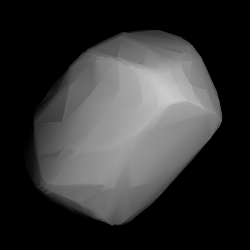Astronomy:118 Peitho
 3D convex shape model of 118 Peitho | |
| Discovery | |
|---|---|
| Discovered by | Karl Theodor Robert Luther |
| Discovery date | 15 March 1872 |
| Designations | |
| (118) Peitho | |
| Pronunciation | /ˈpaɪθoʊ/[1] |
| Named after | Πειθώ Peithō |
| A872 EA | |
| Minor planet category | Main belt |
| Adjectives | Peithoian /paɪˈθoʊ.iən/ |
| Orbital characteristics[2] | |
| Epoch 31 July 2016 (JD 2457600.5) | |
| Uncertainty parameter 0 | |
| Observation arc | 144.05 yr (52615 d) |
| |{{{apsis}}}|helion}} | 2.8353 astronomical unit|AU (424.15 Gm) |
| |{{{apsis}}}|helion}} | 2.03988 AU (305.162 Gm) |
| 2.43757 AU (364.655 Gm) | |
| Eccentricity | 0.16315 |
| Orbital period | 3.81 yr (1390.1 d) |
| Average Orbital speed | 18.95 km/s |
| Mean anomaly | 51.1620° |
| Mean motion | 0° 15m 32.328s / day |
| Inclination | 7.7427° |
| Longitude of ascending node | 47.701° |
| 33.403° | |
| Earth MOID | 1.05849 AU (158.348 Gm) |
| Jupiter MOID | 2.4367 AU (364.53 Gm) |
| TJupiter | 3.473 |
| Physical characteristics | |
| Dimensions | 41.73±1.5 km |
| Mass | 7.6×1016 kg |
Equatorial surface gravity | 0.0117 m/s2 |
Equatorial escape velocity | 0.0220 km/s |
| Rotation period | 7.8055 h (0.32523 d)[2] 7.823 h[3] |
| Geometric albedo | 0.2240±0.017 |
| Physics | ~178 K |
| S | |
| Absolute magnitude (H) | 9.14 |
Peitho (minor planet designation: 118 Peitho) is a main-belt asteroid. It is probably an S-type asteroid, suggesting a siliceous mineralogy. It was discovered by R. Luther on March 15, 1872, and named after one of the two Peithos in Greek mythology. There have been two observed Peithoan occultations of a dim star: one was in 2000 and the other in 2003.[4][5]
This body is orbiting the Sun with a period of 3.81 years and an eccentricity (ovalness) of 0.16. The orbital plane is inclined by 7.7° to the plane of the ecliptic. The cross-section diameter is ~42 km. In 2009, Photometric observations of this asteroid were made at the Palmer Divide Observatory in Colorado Springs, Colorado. The resulting asymmetrical light curve shows a synodic rotation period of 7.823 ± 0.002 hours with a brightness variation of 0.15 ± 0.02 in magnitude. This was reasonably consistent with independent studies performed in 1980 (7.78 hours) and 2009 (7.8033 hours).[3] The lightcurve inversion process has been used to construct a model of this object,[6] suggesting a blocky shape with flattened poles.
References
- ↑ 'Pitho' in Noah Webster (1884) A Practical Dictionary of the English Language
- ↑ 2.0 2.1 Yeomans, Donald K., "118 Peitho", JPL Small-Body Database Browser (NASA Jet Propulsion Laboratory), https://ssd.jpl.nasa.gov/sbdb.cgi?sstr=118, retrieved 12 May 2016.
- ↑ 3.0 3.1 Warner, Brian D. (October 2009), "Asteroid Lightcurve Analysis at the Palmer Divide Observatory: 2009 March-June", The Minor Planet Bulletin 36 (4): pp. 172–176, doi:10.1016/j.pss.2012.03.009, Bibcode: 2009MPBu...36..172W.
- ↑ von Boinik, I. F. B.. "Planet (118) Peitho". Astronomische Nachrichten 145: 31. doi:10.1002/asna.18981450107. Bibcode: 1897AN....145...31V. http://articles.adsabs.harvard.edu/full/seri/AN.../0145//0000021.000.html.
- ↑ "NASA Planetary Data System". http://pdsproto.jpl.nasa.gov/catalog/target/Results.CFM?resultsselbox=118%20PEITHO.
- ↑ Franco, Lorenzo et al. (July 2020), "Spin-Shape Model for 118 Peitho", Bulletin of the Minor Planets Section of the Association of Lunar and Planetary Observers 47 (3): 169–171, Bibcode: 2020MPBu...47..169F
External links
- Lightcurve plot of 118 Peitho, Palmer Divide Observatory, B. D. Warner (2009)
- Asteroid Lightcurve Database (LCDB), query form (info )
- Dictionary of Minor Planet Names, Google books
- Asteroids and comets rotation curves, CdR – Observatoire de Genève, Raoul Behrend
- Discovery Circumstances: Numbered Minor Planets (1)-(5000) – Minor Planet Center
- 118 Peitho at AstDyS-2, Asteroids—Dynamic Site
- 118 Peitho at the JPL Small-Body Database
 |

